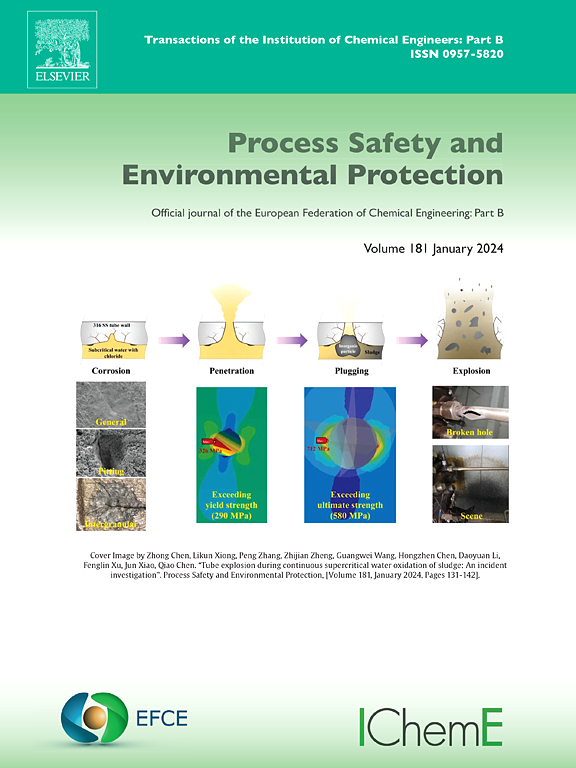相图指导下磷石膏与废盐水合成(NH4)2Mg(SO4)2.6H2O和(KNH4)Mg(SO4)2.6H2O肥料
IF 7.8
2区 环境科学与生态学
Q1 ENGINEERING, CHEMICAL
引用次数: 0
摘要
海水淡化厂排放的盐水含盐量异常高,含有各种对环境有害的化合物。同时,磷酸盐工业向海洋生态系统或生产地点附近的陆地表面释放了大量磷石膏,对土壤和水生环境产生了不利影响。为了应对环境问题,本研究旨在通过生产(NH4)2Mg(SO4)2.6H2O (NMgS)和(KNH4)Mg(SO4)2.6H2O (KNMgS)作为农业肥料,对磷石膏(PG)废物进行再利用并去除盐水(RBW)。实验采用沉淀法和Merseburg法分别从RBW和PG中回收起始试剂MgSO4·7H2O / K2SO4和(NH4)2SO4。因此,基于Mg2+ - NH4+ // SO42- - h2o和K+- Mg2+ - NH4+ // SO42- - h2o两种体系在0℃和25℃下的相图数据,进行了nmg和knmg的合成和结晶工艺。为了验证所制备产品的质量,使用了不同的互补技术(XRD, DTA/DTG, SEM/EDS和Raman)。结果表明,生产的肥料纯度高,含有较高水平的植物生长所需的土壤营养元素(即K、N、S和Mg)。结论是,本工作中应用的方法可以帮助研究人员提出利用相图平衡管理和回收几种废物的新方法,促进有用化合物(如肥料)的制造。本文章由计算机程序翻译,如有差异,请以英文原文为准。
Phase diagram-guided synthesis of (NH4)2Mg(SO4)2.6H2O and (KNH4)Mg(SO4)2.6H2O fertilizers from phosphogypsum and reject brine water
The brine water discharged by desalination plants has exceptionally high salinity levels and contains various chemical compounds that are harmful to the environment. Concurrently, the phosphate industry releases a substantial quantity of phosphogypsum into marine ecosystems or onto terrestrial surfaces near the manufacturing sites, adversely affecting the soil and aquatic environments. In response to environmental concerns, this study aims to valorize phosphogypsum (PG) waste and reject brine water (RBW) by producing (NH4)2Mg(SO4)2.6 H2O (NMgS) and (KNH4)Mg(SO4)2.6 H2O (KNMgS) for use as fertilizers in agriculture. Experimentally, the starting reagents MgSO4·7 H2O / K2SO4 and (NH4)2SO4 were recovered from RBW and PG by precipitation and the Merseburg process, respectively. Thus, the manufacturing process for NMgS and KNMgS synthesis and crystallization were performed based on the phase diagram data of the two systems Mg2+ - NH4+ // SO42- -H2O and K+- Mg2+ - NH4+ // SO42- -H2O at 0 and 25°C. To verify the quality of the prepared products, different complimentary techniques were used (XRD, DTA/DTG, SEM/EDS, and Raman). The obtained results revealed that the produced fertilizers are of high purity and contain elevated levels of soil nutrient elements (i.e., K, N, S and Mg) required for plant growth. It is concluded that the approach applied in this work can help researchers to propose new ways to manage and recycle several wastes using phase diagram equilibrium, facilitating the manufacturing of useful compounds such as fertilizers.
求助全文
通过发布文献求助,成功后即可免费获取论文全文。
去求助
来源期刊

Process Safety and Environmental Protection
环境科学-工程:化工
CiteScore
11.40
自引率
15.40%
发文量
929
审稿时长
8.0 months
期刊介绍:
The Process Safety and Environmental Protection (PSEP) journal is a leading international publication that focuses on the publication of high-quality, original research papers in the field of engineering, specifically those related to the safety of industrial processes and environmental protection. The journal encourages submissions that present new developments in safety and environmental aspects, particularly those that show how research findings can be applied in process engineering design and practice.
PSEP is particularly interested in research that brings fresh perspectives to established engineering principles, identifies unsolved problems, or suggests directions for future research. The journal also values contributions that push the boundaries of traditional engineering and welcomes multidisciplinary papers.
PSEP's articles are abstracted and indexed by a range of databases and services, which helps to ensure that the journal's research is accessible and recognized in the academic and professional communities. These databases include ANTE, Chemical Abstracts, Chemical Hazards in Industry, Current Contents, Elsevier Engineering Information database, Pascal Francis, Web of Science, Scopus, Engineering Information Database EnCompass LIT (Elsevier), and INSPEC. This wide coverage facilitates the dissemination of the journal's content to a global audience interested in process safety and environmental engineering.
 求助内容:
求助内容: 应助结果提醒方式:
应助结果提醒方式:


